Katoey Show/The Mighty 85mm, A Portrait Lens

|
• Rimonim Hermon Holiday Village Hotel • Jericho Resort Village • Ramon Inn Hotel • Rimonim Optima Tower Hotel |
Thank you for your generous contributions. We're slowly collecting enough images to make the mosaics. I realize I'm posting the same paragraph each week, but I assure you we're on top of this project and doing our best to collect enough of the proper type of images to make the best possible set of mosaics. This is proving difficult so please help if you can.
We are still accepting (and pleading for) images of children from SEA. No matter how terrible you think they are, please send them in anyway. These images will be used to complete a set of 3 high quality mosaics which will be sold to benefit the Karen and Burmese Orphans living in the orphanages and refugee camps. The more images the better, I can use all you have. Please take the time to go through your images for anything you think might help. If you missed the "No Place to Call Home" special, you can click on the link and read more about this. Thank you! QandA@Bkkimages.com
Feature Photograph

85mm, F8, 1/200th, ISO 100
There is much to Thailand the casual tourist never sees. And there are other parts of Thailand that even the seasoned expat never sees. One such place is the insurgent South. I would never recommend anyone venture down there on their own just to say they've
been there. On the other hand there are some very worthwhile venues to visit in the south and one is the master kris maker in Yala.
This is the only master kris maker in all of Thailand. I've been to his home and inside his workshop and met his family. I own several of this works of art, several purchased and one received as a gift. To watch this dedicated Muslim family at work
and in life is truly a privilege. Recently a client asked me if I could arrange a workshop to Yala where we could meet this family, photograph them at work, and perhaps even arrange to carry back a personal kris.
In all honesty I hesitate. It's okay for myself, but to take the responsibility for others in such a violent and dangerous area would be both costly and require strict planning and adherence to the plan by all involved. Considering the cost and required
strict obedience would people still be interested in such a workshop? Perhaps.. there are many great things to see and I could arrange for all of them. A visit to the master kris maker, the bigger mosques and temples in the area, and exposure
to the unusual and interesting people of the south.
This image is significant because I've discovered a suitable method for processing which shows the multiple layers of this hand hammered steel blade. A blade that can take more than 2-3 weeks to form as it's folded over and over again. Each
layer hammered until it melds into the previous layer. A blade which is purpose designed to reflect the spiritual side of it's intended owner. The intricate detail of this blade combined with the strength and flexibility is representative
of the people of the south.

85mm, F8, 1/200th, ISO 100
I always emphasize to take the best quality image you can in all circumstances. This is a relatively boring image many would delete from their camera before even returning home. Captured in 2005. I could see with my eyes in the changing light so much
more than I was able to photograph without a proper macro lens and studio lighting and even then I wasn't sure. I didn't have this equipment with me anyway, so I was left doing what I could with what I had in my bag.
Five years later while reviewing a new piece of software, the inherent capabilities of the software prompted me to remember these images. Fortunately I had taken great care in the selection of my lens, depth of field, and focus. The resulting image in
my humble opinion is striking. I hope you agree.
Katoey Show
The Katoey Show
 Tom Tweedel is a good friend with significant experience in China and has self-published several interesting volumes of his travels in China complete with many great images and informative narrative. Last year he visited Thailand for the first time and I had a great time showing him around the area. Somehow he found time to put together a like 364 page book of his travels around Thailand!
Tom Tweedel is a good friend with significant experience in China and has self-published several interesting volumes of his travels in China complete with many great images and informative narrative. Last year he visited Thailand for the first time and I had a great time showing him around the area. Somehow he found time to put together a like 364 page book of his travels around Thailand!
When Tom agreed to become part of our small select product review team I was both excited and grateful. I hope you enjoy this and future reviews by Tom. For those whose plans include extended travel in Thailand and China I’d recommend contacting
Tom and inquiring into obtaining copies of his books. Tom Tweedel is an Austin, TX based photographer and can be reached at: tomsds@austin.rr.com
One of the popular things on a lot of tour groups “to do” lists are the Katoey shows. Katoeys are men who dress, act like and in some cases have been surgically altered to be like women. It was also one of the things on my wife’s
“to do” list. There are a number of shows throughout Bangkok, this particular one was at a high end hotel.

The Opening Act
The show was a cabaret style variety show with many different acts. The opening act was Vegas style with lots of sequins, feathers and legs.

The Audience
The show was clearly for tourists. The majority of them were middle aged women from Europe and Korea. I doubt many locals would go to the show as it was outrageously expensive by local standards (1200 baht / $36US).

Singing
A recurring act in the show was to have a lone Katoey, dressed in formal evening wear come up and sing a solo. They didn’t really sing, they just lip synced to some famous western singer.
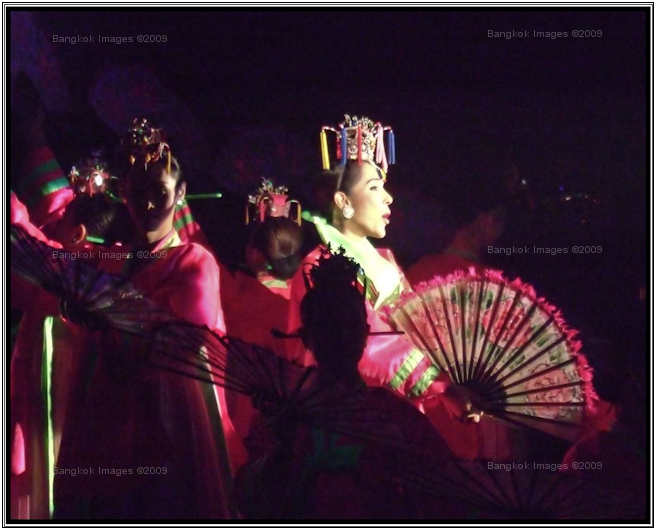
The Korean Act
To appeal to the international nature of their audience they had different acts in different languages. English, American, French, Korean, Chinese, Japanese and Thai. This was the Korean act where the cast got dressed up in Traditional Korean outfits
and lip synced to a Korean song.
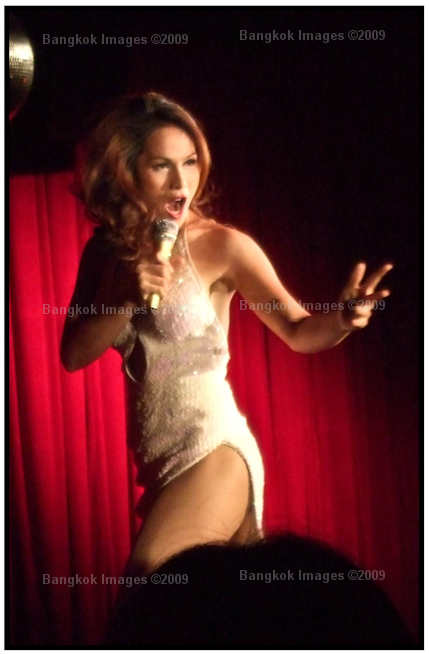
The American Act
Blonde hair and a faster beat.
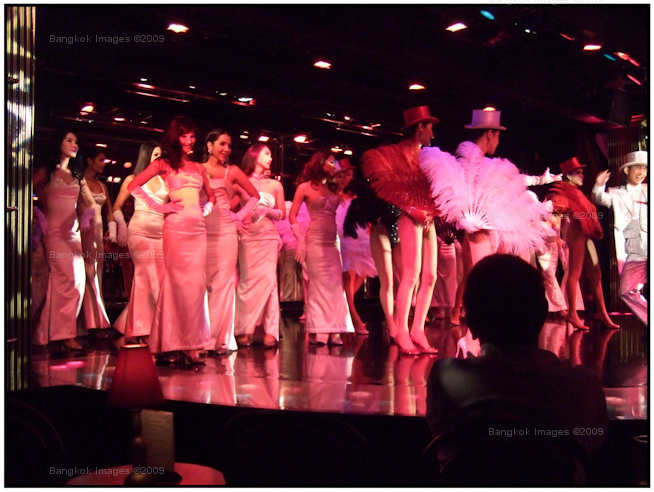
The Whole Cast
This act seem to involve the entire cast getting up there and singing and dancing.

Not all Katoey Action
The show wasn’t entirely made of Katoeys. They had a number of non-emasculated men up there in supporting roles.

The Chinese Act
This act was something about gangsters, a bad boy and his bride.

The Thai Act
The Ethnic Thai themed act had a singer in a fairly fearsome outfit singing in Thai.

The French Act
They had a lone singer in red giving an emotional looking solo performance.

Polynesian Theme
I don’t know what this act was about but the Katoey being carried around was amazingly delicate and feminine.

Legs
This act had some guys really showing their legs.

The Central American Fruit Dance
For lack of better explanation this act seemed to be an homage to the Chiquita Lady.

Shake Em Boys
At times it was hard to believe that it was nothing but guys up there on stage.

Meet the Cast
After the show they cast lined up against the back wall for a meet and greet.

Some of the Cast Close Up
You had a variety of different looks here. Some were easy to tell, some not so easy.

Close Up
A close up of three Katoeys my wife was particularly interested in.

Hard to Tell
After the show when we were leaving the hotel we ran into a few of them (including the one in the middle). In the street lights they looked just like women to the average glance. If we hadn’t just seen them on stage we wouldn’t have thought
anything of it. That should be a word of warning to guys who are drunk in a dimly lit bar..

Star of the Show
For some reason this performer was the “star” of the show. He was in more of the acts and was the lead on many of them. Maybe because he could dance?
The Mighty 85mm, A Portrait Lens
Introduction
During almost every workshop the subject of the ideal portrait lens and its use finds its way into the discussion. We can be sitting in a speedboat humping 60 knots over rough chop and my client seeing an especially pretty woman on water skis will say
"what's the best portrait lens.." We'll be riding elephants in a Cambodian jungle shooting the rare Khmer Dodo bird when a half naked jungle girl in a grass skirt runs across our path
and the client asks "what's the best portrait lens.." Okay, I made that last one up but you get the point. No matter what subject we normally shoot, we'll always be interested in shooting
our favorite people with the highest possible quality.
So what is the best portrait lens? This might shock you but there isn't one. Portraits are about creativity as much or more than anything else. Our subject, the setting, their mood/expression, how we put it together determines the ideal lens of the
moment and how we use it. Certainly the 85mm focal length is one of the most popular portrait lenses if not the most popular.
The manufacturers usually make two 85 mm lenses. A relatively fast (F1.8) aperture with fast autofocus and very good quality at a moderate price point, and a super fast (F1.2 – 1.4) aperture with much slower autofocus and a price point that sits alone
way up there at the top. The latter is what we're going to discuss today.
Application
These super fast lenses are very much specialty lenses. They take special knowledge and training to use properly otherwise the purchaser is invariably disappointed which most often results in a rant on a photography forum and a return to their favorite
camera retailer.
The extreme wide aperture requires a rather large chunk of glass which makes it heavy and in the case of the Canon 85mm F1.2L that heavy glass takes some shoving around by the autofocus system so it's geared low and takes a while to autofocus. Not
because it has trouble finding the AF point, with all that light coming in it finds the AF point very fast. But because the glass is physically heavy and moving it requires some power. Also, because the depth of field (DOF) is so narrow, precision
is key further reducing the gearing to a crawl.
This isn't the lens to use for sports or even children playing ball. This is a lens specially built to capture great detail with an extremely shallow DOF, excellent color rendition, and great contrast. The design will also include more aperture blades
designed to produce the much desired holy grail of bokeh.. the perfectly round bokeh character. Canon's 85mm F1.2L does this better than any other 35mm format lens I know of.
Technique
Proper technique is key. The camera should be set to "one-shot" or static autofocus with only a single AF point activated. You can select the AF point which is closest to the closest visible eye
of the subject. Center this AF point on the closest visible eye. This can take some practice. At this focal length, and because not a single one of these 85's comes with IS/VR, you'll need a very steady hand. Because portraits involve
interacting with the subject you'll also need to move quickly while holding the camera steady as you prompt the desired poses and expressions. Pre-focus and pre-meter, strike the mood, make the capture.
When shooting at the wider apertures, F1.2 – F2, it wouldn't be unusual to make 20 captures of the same subject / expression, and have only a single frame turn out perfectly focused. The DOF is so shallow, and this lens requires such perfect technique,
that it takes a great amount of practice to use this lens with any sort of competence. Practice, and practice some more, and then again some more before even considering the lens may be back focusing, front focusing, or whatever the popular excuses
are you'll read on the forums.
I've purchased over 50 high end Nikkor and Canon lenses over the last 8 – 9 years and haven't had to return even one of them. And as you know from reading this column I'm very keen on sharpness. You can rest assured, if the lens isn't
achieving the desired focus it's faulty technique and not the lens.. in almost all cases.
Examples
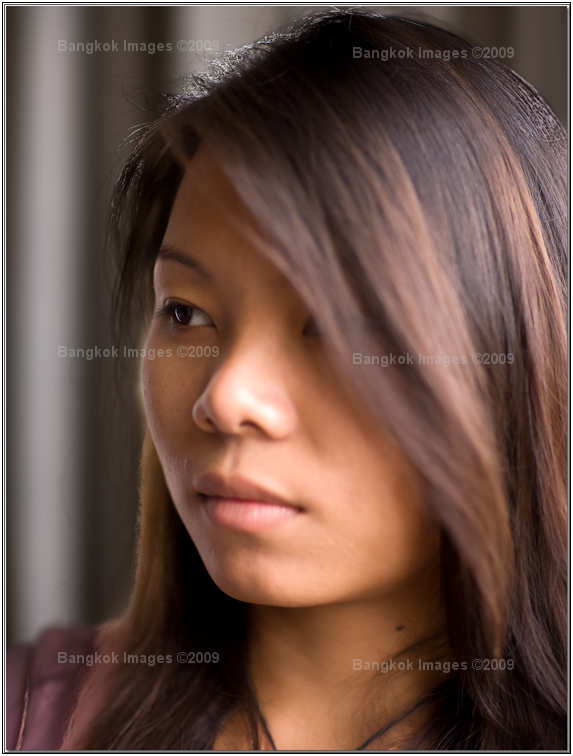
85mm F1.4
Above is a standard generic head shot. Notice the only visible eye is the eye furthest from the camera? This would be an exception to always shooting the closest eye. You always choose the closest visible eye and place the AF indicator squarely on the
eye. At F1.4 the DOF will be so shallow on an inch or so in each side of the AF point will be in sharp focus. From there focus will fall off sharply in both directions, front to back, of the frame.
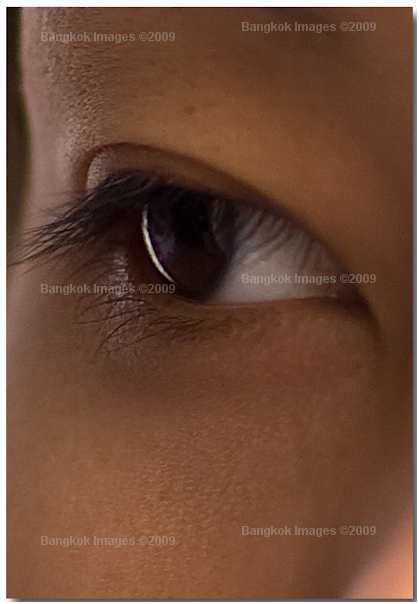
85mm F1.4
Above is a crop of eye. Notice how perfectly detailed the eyelashes are? Without sharpening or other processing this is the level of sharpness you should expect from perfect technique and a quality 85mm lens.
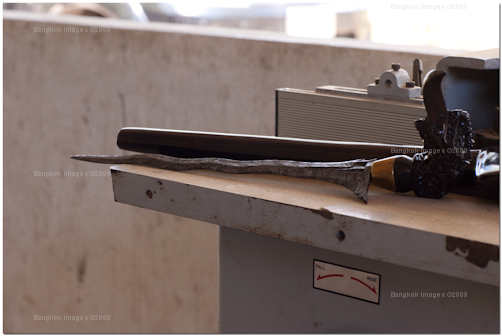
Kris sitting on a shaper in Yala approximately head on to the camera
During a visit to Yala I had the opportunity to photograph the beautiful craftsmanship of handmade kris' and a search through my camera bag turned up the 85mm F1.2 as the best choice. The setting was less than desirable so I knew I'd want a
shallow DOF for later processing if I wanted to do anything with the resulting images. For the sake of having the most choice I started with F1.4 on the center of the blade and stopped the lens down to F2, F4, and F8.
Interestingly enough the angle of the kris is about the same as the face of a person would be if you were taking their portrait. On a human face it's often hard to visualize exactly how much DOF there is because features blend and there's no
consistent reference point. A search through my database turned up these shots of the kris' ideal to visualize DOF.
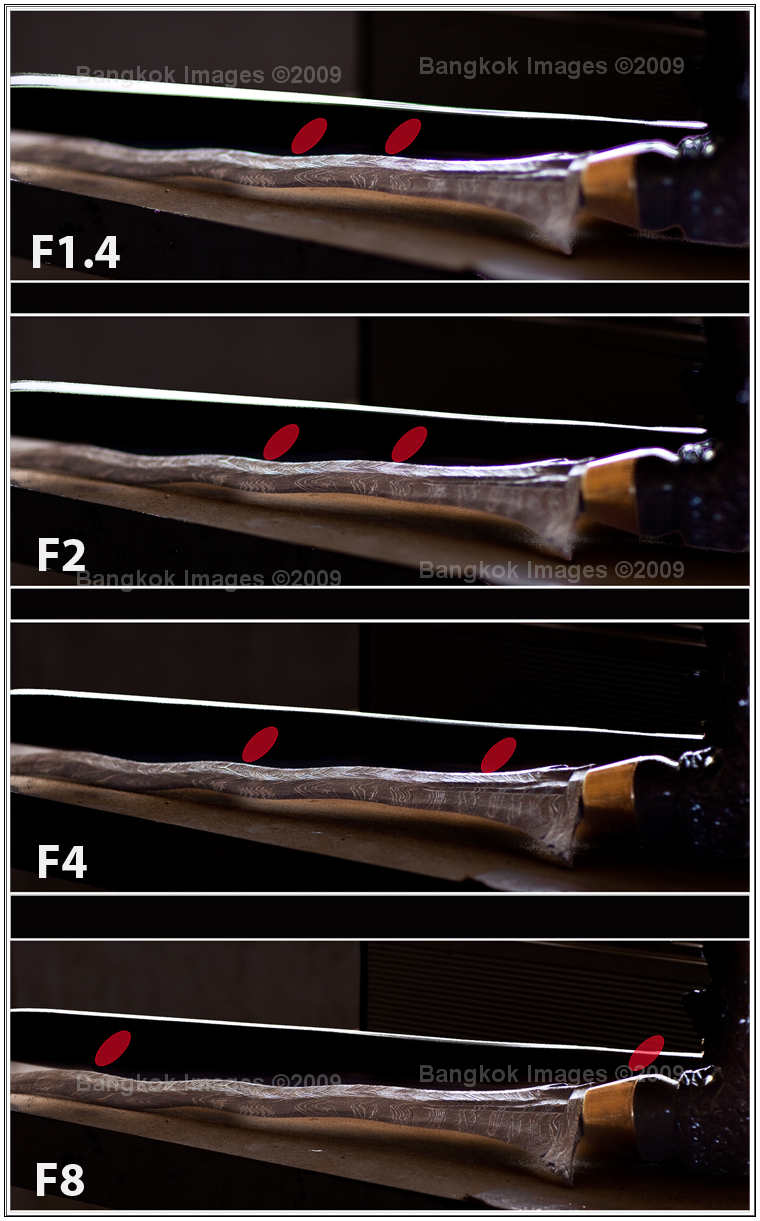
Depth of field is indicated by the red markers
The red markers show the exact point where the focus goes from sharp to defocused. These images are still on the small side to easily see DOF, but with the aid of the red markers you should have a good idea. Notice that at F1.4 we have a mere 2 inches
of focus? At F2 about 5 inches, and by F4 about 8 inches. By F8 we have close to 12 inches of focus.
Compare these distances centering on a headshot and the closest eye. Two inches takes you from the eye inwards to the start of the nose, and outwards to the side of the face. 5 inches includes hair on the far side, and a bit of cheek on the inside. F4
pretty much covers the entire face, while with F8 we're starting to get most of the hair in focus.
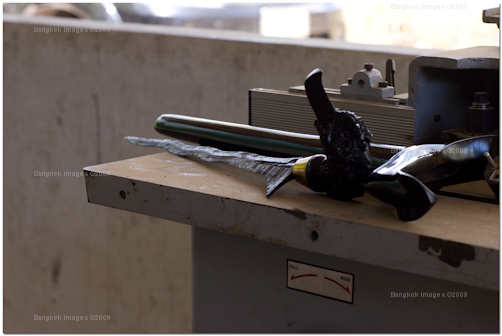
Kris sitting on a shaper in Yala at a 45 degree angle
This angle and distance is used often for head shots. In fact it is the same angle used for the headshot above.
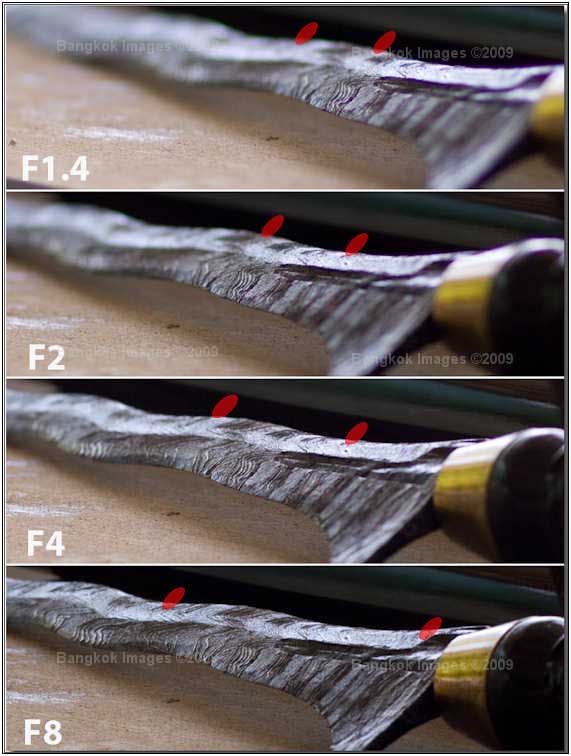
Depth of Field indicated by red markers
Again, another example of DOF which should help you visualize just how much of a human face will be in sharp focus at a 45 degree angle using these apertures at 85mm. Because the angle increased you'll notice the distances appear to have closed.
They have. If you can't visualize this try drawing it out on paper and drawing two inch lengths across different angles.
Conclusion
Achieving super sharp results at wide open apertures is very possible with the top quality 85mm lenses. It will take a practiced technique and a great deal of patience, but then you can reliably achieve such results. What should you expect as a reward?
Let's take a look at a very ordinary headshot:
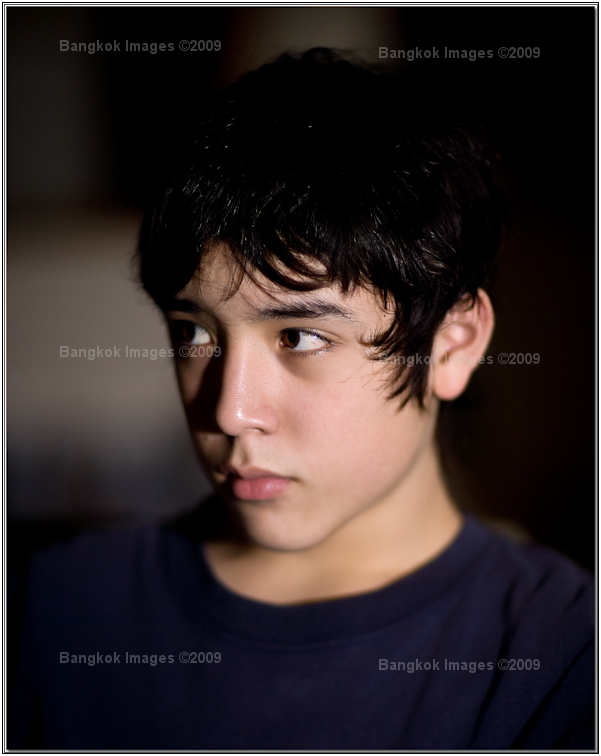
85mm F1.2
The subject is at a 45 degree angle with his closest eye towards us visible. At F1.2 his eye will be perfectly sharp and the DOF will extend halfway up the bridge of his nose. From there everything gently fades into a perfect bokeh. Notice how due to
the depth of bokeh that we can't even tell what the background is?
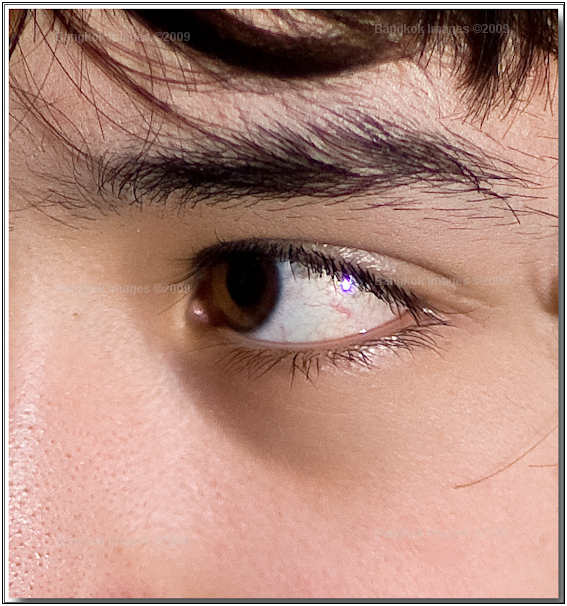
crop of eye at f1.2
The above crop reveals a tack sharp eye. Sharp enough to clearly see each eyelash and small veins in the white of the eye. Sharp enough to see the dirt in the pores of the skin! This image was shot wide open at F1.2. I can't imagine wanting any more
sharpness in a portrait. Can you?
A high quality 85mm portrait lens will give you all the practical sharpness you could ever desire at its widest aperture. The color will be accurate, the contrast appropriate, and the bokeh smooth and creamy. The lens will become sharper as you stop it
down, but not much. Stopping down such a lens is done purely for creative purposes, not for sharpness.
Again, a high quality 85mm is a specialty lens. It's an extreme lens which will give you extremely sharp results, extremely great bokeh, and allow you to shoot in extremely low light. It also takes an extreme amount of practice and perfect technique.
It's an extreme lens. I love mine.
Photography News of Interest
Yikes! Shaken down by private security guards for your flash memory cards. I'm not a fan of the paparazzi and I acknowledge
they can be truly annoying to celebrities and anyone else they target. So it's hardly surprising when the push their way into a private event, take pictures they weren't authorized to take, and then run for it.. that occasionally they'd
get caught. Tom Brady and supermodel Gisele Bundchen were both annoyed I'm sure. However,
when the security guards rough them up and discharge a bullet near their head things 'might' have went too far. You can read about it here.
While most image professionals use Photoshop CS4, it's still a very expensive program costing far more than most hobbyist want or need to pay when you consider the competition. This
is why long ago they started marketing Photoshop Elements. At first Elements was annoying at best, but these days it's evolved into a truly useful program with just about every feature
you're probably looking for. Adobe recently released Photoshop Element 8 for Windows and Mac. You can read about it here.
Panasonic is enjoying a hot success with their new "micro 4/3's" cameras, the G1,G1H,
and now the GF1. With the micro 4/3's being a fairly new system lenses are in short supply so it's only natural new lenses will be released fairly often. Panasonics latest offering
is a very useful 20mm F1.8 ASPH (40mm equiv) which promises very good quality. You can read DPR's test review of this lenshere.
98 years old and still going strong! This 98 year old photographer is having a gallery exhibit at the Dyersburg State Community College. You can't help but be impressed. Still achieving
at 98! Read more about this amazing womanhere.
The Olympus E-P1 is a truly small pocket digital camera with a micro 4/3's sensor. A 4/3's sensor is much bigger than the sensor in your standard point and shoot and subsequently
the images have a much higher quality as well. A nostalgic style married to modern image quality makes this small and attractive camera truly different. Read one of the first reviews of a fully production model here.
Readers' Submissions
Steve-
In The Netherlands:

Passion flower in the garden
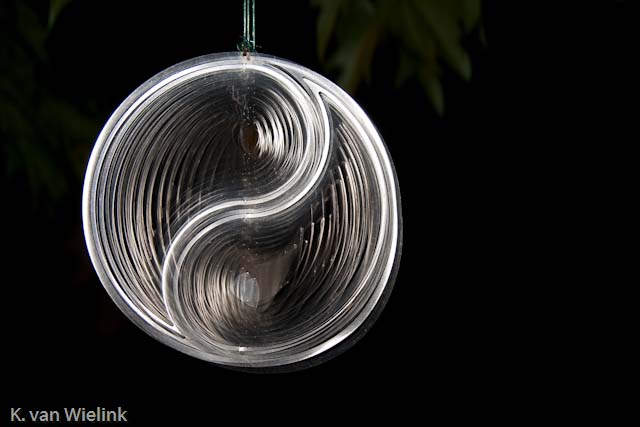
Playing with my new flash

Church bell tower
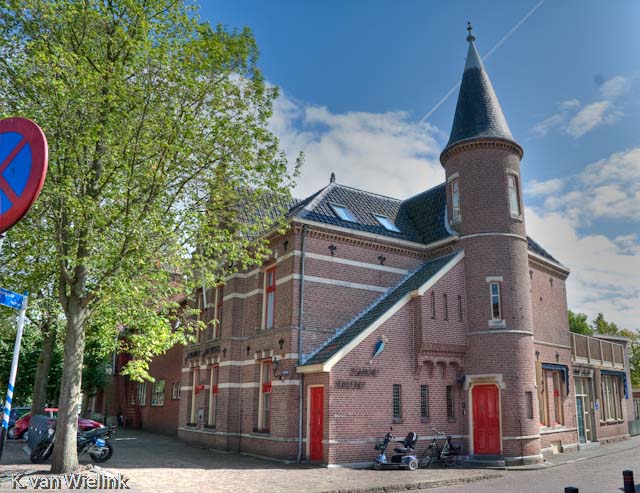
Nice building. Used to belong to the local church (HDR)
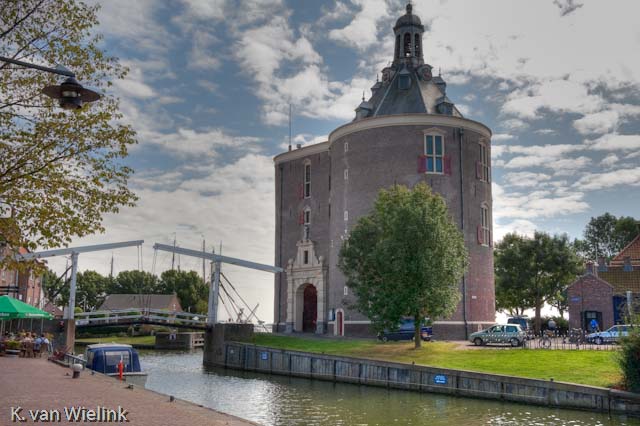
Well known building in Enkhuizen. Used to be part of the city defense wall (HDR).
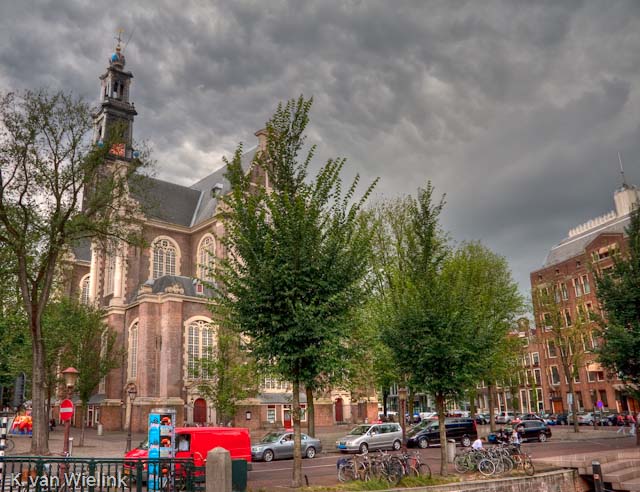
Cathedral in Amsterdam (HDR)
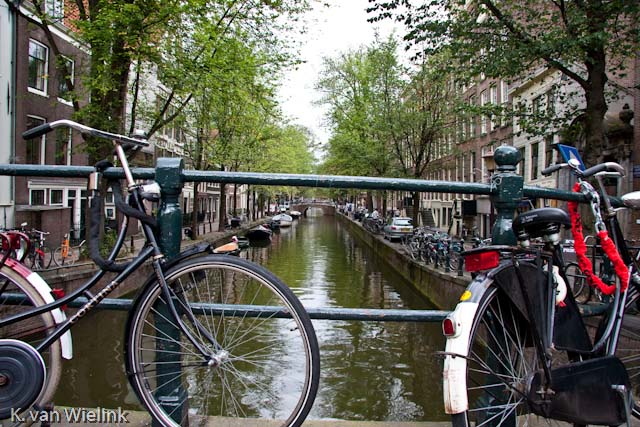
A more typical shot of Amsterdam would be hard to find…
In Singapore:
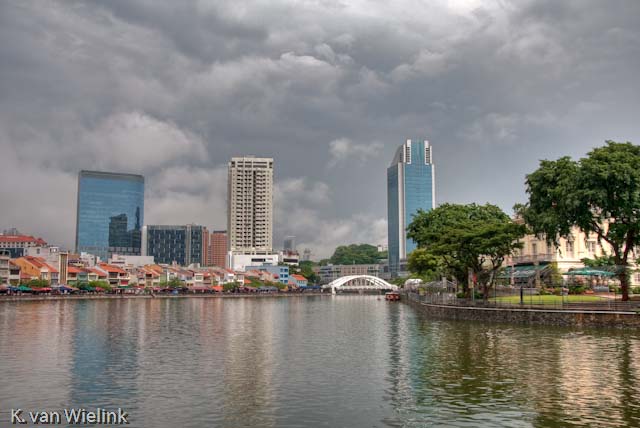
Shophouses on the river near Raffles Place (HDR)
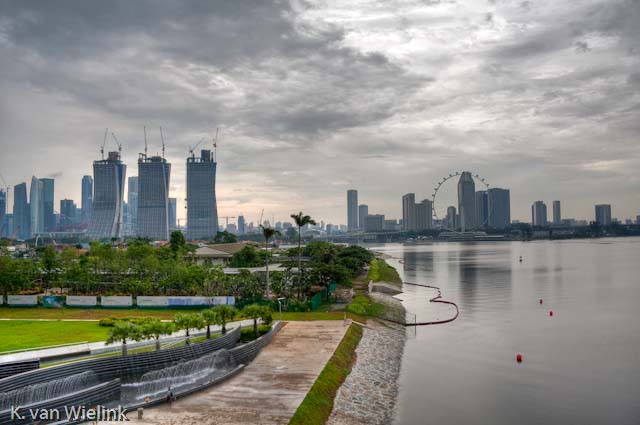
View from atop the new Marina Barrage (HDR)
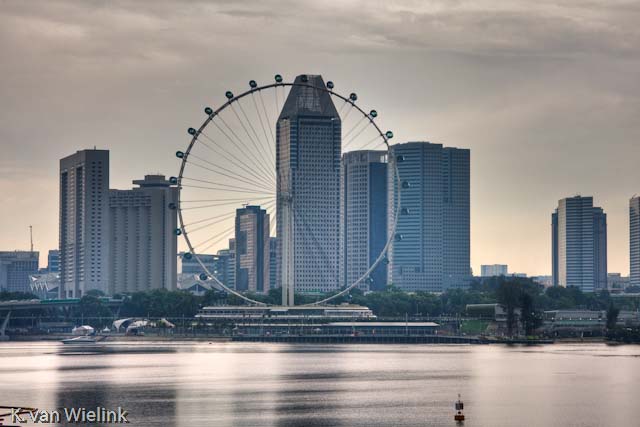
Also taken from the Marine Barrage, this time a close up of the Singapore Flyer (HDR)
KVW
KVW –
I love these pictures! You're photography is improving at a fast pace.
It's great to see images from other parts of the world. I'm looking forward to more!
Steve
I suspect the readers submissions will be a highly anticipated section of this column and I encourage anyone with photographs and travel accounts they'd like to share to please send them to me at: QandA@Bkkimages.com
Readers' Questions
BKKSteve;
I keep hearing and reading "expose to the right." What does this mean?
Love your column and look forward to it every Sunday.
Keith-
Hello Keith –
Thanks for reading my weekly. It comes out before 1800 each Saturday. Stick's regular weekly column comes out exactly 24 hours later on Sunday.
"Expose to the right" is the new digital camera exposure rule. Well, not exactly new, we've been doing it since the first histogram was integrated into a digital cameras
LCD. Basically it means to expose until the histogram reads as far to the right as possible.
Please look for a more detailed answer as the learning topic in next week's column. It will be worth reading!
Steve
Steve
My plans are to rent a car and drive around northern Thailand and hopefully see some of those landscapes you keep showing us. My questions is security. Do you leave your camera gear in your car or carry it in your room with you each night? Do you take
it in with you when you eat? I ask because I'll be carrying a few thousand dollars worth of equipment with me and I don't want to lose it. Thanks
Greg
Greg –
I'm not going to share all of my secrets but I'll share some. I routinely travel with in excess of $50,000 USD of equipment. I've been doing this for years and have never had an issue. Perhaps I've been lucky, but I like to think I've
also been careful.
My SUV has purpose-applied dark tinting in the rear and on the sides. Even with a powerful flashlight someone looking in will not be able to see my equipment cases in the far rear of my vehicle. I also have a quality alarm installed.
Do I take my gear inside the room? For me it's all about visibility. If no one knows you have expensive gear with you, then no one will try to take it. Parading through the hotel lobby with expensive looking equipment bags alerts every worker and
guest in the place that you'll have expensive gear available in your room. Some of these workers can then notice when you're out of your room. Do the math. Even in a top hotel you must remember your gear could be worth more than several
years' salary for general workers. Do you want to tempt them?
What about leaving it in the car? First, I make sure that my care has nothing else about it which will attract thieves. No GPS left on the window, no fancy car stereo, and nothing visible in the area of the car you can see into. No fancy wheels / tires
either. Next, I have a hard and fast rule about never opening the rear of my car where anyone can see my equipment cases. I'll stop on the side of the road before arriving at my destination and put away equipment, and arrange cases so I (or
the hotel bellhop) can remove my luggage from a side door vs. the rear door where the equipment can be viewed. Gas stations are also good for this. I fill up at the end of the day, move luggage, put away gear, and eliminate the need to expose
my equipment once I arrive at the hotel.
Still, there are some areas where I'll go to extremes. Any tourist area that attracts well off tourists will also attract thieves who prey on well off tourists. Hua Hin and Pattaya come to mind. I leave nothing in the car, or in the room unattended.
I take my gear in with me and stay with it. If I want to go out for the evening there are a few choice hotels where I know they take security very personally and I've done work for these hotels and I trust them. They might be pricey, but
I consider it cheap insurance. In the more rural parts of Thailand I'm not nearly so concerned.
Also, keep in mind that your equipment might be worth enough to motivate someone to rob your person. This is Thailand where the average worker often makes less in a year than what they could get for the contents of your camera bag.. so don't tempt
fate. Be smart and be careful.
I hope this helps
Steve
Please submit your questions to QandA@Bkkimages.com All questions will be answered and most will show up in the weekly column.
A Snapshot of Bangkok Images Week in Review
Another slow week. A single workshop and not much more. I lost my two main monitors, both went out within two days of each other. This is a reoccurrence of the same monitors that went out about six months ago. I had them repaired then and I'll take
them in for repair again, however it's becoming more obvious I'll need to replace my main workstation monitors at the earliest possible date. The main issue is the quality of monitor I need isn't sold in Thailand so I'll have
to figure out a way to import them.
Also please note, as I've previously mentioned obligations and duties have precluded me getting out of town where I gather my usual material for the weekly. I want to thank Tom Tweedel for putting together some material for us from his travels in
Thailand. He's only had the single visit so his comments and views are particularly interesting coming from a first visit point of view. Thank you Tom. Your generosity allows the column to be complete and not full of holes.
Infocus Blog
What You See, Might Not be What You Get!
Infocus Weekly has covered profiling monitors on many occasions. Yet, every once in a while I'm still gobsmacked when someone is seeing colors in an image which aren't supposed to be there. This time is happened like this:

12mm, F11, 8 seconds, ISO 100
BKKSteve: I just emailed you a proof image. What do you think?
Her: Nice! The blue colors are really beautiful.
BKKSteve: Blue colors? What blue colors? Where are you seeing blue colors?
Her: In all the places you put blue.
BKKSteve: I didn't put blue hardly anywhere. Where are you seeing blue?
Her: The image on the television, the sky/clouds outside, and the computer monitors have purple fruit.
BKKSteve: Umm.. the image on the television is 100% lavender, the clouds outside are grey, and the 'apples' on the monitor are red.
Her: No.. they're not…
By now regular readers are recognizing the signs of an un-profiled monitor. Usually the color shifts are much less extreme. Most often they'll appear to be the same colors but a different shade. This is why it's difficult for most people to
see the value in profiling their monitor. In their eyes it's already "good enough" and that is that.
In this case the image in question has complex color. I won't go into how much work it took to produce this image or how most people think an image like this can be achieved in Auto mode with a pop-up flash. We really won't go into how most
people could capture this scene with their camera in Auto mode with their pop-up flash, compare it to the image above, and not see a difference. As photographers we just have to accept that some people will never appreciate our work.. ;o)

12mm, F11, 9 seconds, ISO 100
Color profiling your monitor is important. It ensures that when someone goes to the trouble of processing an image, tags it with the SRGB color space, and emails or puts it on the web, that you will indeed be able to view the image as it was intended
to be viewed. And of course the opposite is true. If you go to all the trouble of taking nice pictures, processing them, and then uploading them to Flickr or anywhere you want to share them, you want the viewers to see them as you intended.
The problem is that most people are into the "good enough" mindset. And really, with today's great digital cameras most snapshots and family pictures are indeed "good enough for Government work." But as an avid photo hobbyist you want more? You want people to see your images as you intended them.. and so do I.
The best we can do is profile our own monitors, put out the most accurate files possible, and be aware that if a viewers monitor isn't profiled then there will be discrepancies of some measure.
I use this product to profile my monitors and the monitors of my clients. There are others, but this is a general purpose model that can profile laptops, desktop LCDs, and CRTs. The
only thing it can't profile is my HDTV so I have another one for that.
If we profile our own monitors we'll have several main advantages:
- The files we take to the print shop to make prints.. should produce the most color accurate prints. 99.7% of consumer print shops use the SRGB color space/gamut, the same one we use on the web.
- The files we post on the web, when viewed by someone else with a profiled monitor, will appear to that view as you intended them.
- You'll have established a standard.. because if you're monitors aren't profiled, even the different computers in your own household won't view the same image the same way.
When it comes to correctly processing images color profiling is especially important for setting the proper white balance and subsequently the exposure. The first thing we do in a workshop during the processing learning stage is to profile the clients
computer and go over the basics of color management. It's that important. Even if you shoot black and white.. ;o)
Until next time..



